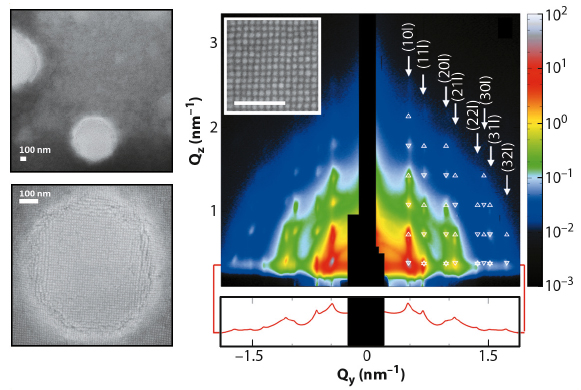- Home
- Users & Science
- Scientific Documentation
- ESRF Highlights
- ESRF Highlights 2011
- Structure of materials
- Shape-induced symmetry in nanoparticle assemblies
Shape-induced symmetry in nanoparticle assemblies
The self-assembly of nanocrystals is a widely investigated phenomenon as the understanding of it promises new routes for the formation of large-scale ordered structures for nanotechnology. Most investigations focus on spherical nanoparticles or binary superlattices composed of different particle sizes or compositions. Because the interactions between the nanocrystal facets are important for self-assembly, slight variations in the nanocrystal shape can lead to profound variations of their arrangements on the mesoscale. We have studied the self-assembly of iron oxide nanocubes with a slight degree of truncation of the corners and report on the influence of the nanoparticle shape on the structure obtained. The resulting mesocrystal structure has been rationalised by evaluation of the van der Waals forces between the adjacent nanoparticle facets.
 |
|
Fig. 37: SEM and GISAXS data of the studied mesocrystals. |
We studied the magnetically induced assembly of iron oxide nanocubes with an edge length of 8.5 nm and a narrow lognormal size distribution of 6%. The nanocubes are truncated at the corners with a degree of truncation of ![]() = 0.45 (derived as
= 0.45 (derived as ![]() = 2 t/l in Figure 38). The presence of a weak magnetic field during evaporation has been shown to promote nanoparticle superlattices with large lateral correlation lengths [1]. In this study, we obtained three dimensional mesocrystals with a micrometre lateral size and several hundred nanometres in height. Scanning electron microscopy (SEM) revealed a square lateral with a face to face arrangement of the nanocubes (Figure 37).
= 2 t/l in Figure 38). The presence of a weak magnetic field during evaporation has been shown to promote nanoparticle superlattices with large lateral correlation lengths [1]. In this study, we obtained three dimensional mesocrystals with a micrometre lateral size and several hundred nanometres in height. Scanning electron microscopy (SEM) revealed a square lateral with a face to face arrangement of the nanocubes (Figure 37).
 |
|
Fig. 38: Illustration of the bct lattice with different interparticle interaction types (top) and the truncated cubic building blocks (centre). Ratio of the interaction energies in a sc and bct lattice (bottom). |
To obtain depth resolution for the mesocrystal structure, grazing-incidence small-angle X-ray scattering (GISAXS) studies were carried out at beamline ID01. The GISAXS pattern obtained revealed sharp reflections which permit a three dimensional crystal structure determination. Purely lateral structural correlations can be assessed in the so called Yoneda line (red line in Figure 37). The width of the sharp reflections confirms the high lateral order observed by SEM with a correlation length beyond the instrumental resolution of 65 nm. Reflections with a component perpendicular to the substrate are located above the Yoneda line. The observation of all hkl reflections in one pattern without rotation of the sample indicates the orientation of the mesocrystals in a two dimensional powder, with a single-crystalline arrangement of the nanoparticles perpendicular to the substrate.
For the nanocube mesocrystals, a body centered tetragonal (bct) lattice has been derived from the GISAXS pattern shown in Figure 37. This is different from the simple cubic (sc) arrangement reported for cubic Fe nanoparticles [2], which can also be inferred from the square symmetry observed by SEM.
To assess the observed preference of the bct arrangement against a possible sc arrangement, we attempted to model the energy of a particle in both lattice types by comparing the energy needed to remove a nanocube from both lattices. The precise knowledge of interparticle separation distances obtained from GISAXS, TEM, and SEM allowed calculation of the van der Waals energies for the different types of interparticle interactions found in the mesocrystal structure, namely face-face, edge-edge, and corner-corner interactions (Figure 38), as a function of the degree of truncation of the nanocubes. In particular, the corner-corner interaction, which depends largely on the degree of truncation of the nanocubes, has been found to dominate the overall interaction energies. Accordingly, the degree of truncation is an essential parameter for the preference of a bct or sc lattice. The ratio between the interaction energies calculated for both lattice types presented in Figure 38 shows that the sc lattice is favoured at a low degree of truncation, whereas the bct lattice dominates at moderate truncation as observed for the nanocubes under study.
In summary, this work presents the formation and structure determination of large mesocrystals of magnetic nanoparticles of a cuboidal shape. The interaction energy estimates support the observed preference of a bct lattice and identify the degree of truncation to be crucial for the mesocrystal structure. The ability to modulate interparticle interactions by a variation of the particle shape is promising for opening a new direction in crystallography, where the mesocrystal structure depends largely on the shape of the primary constituents.
Principal publication and authors
S. Disch (a), E. Wetterskog (b), R.P. Hermann (a,c), G. Salazar-Alvarez (b), P. Busch (a), Th. Brückel (a), L. Bergström (b) and S. Kamali (d), Nano Lett. 11, 1651–1656 (2011).
(a) JCNS and PGI, JARA-Fit, Forschungszentrum Jülich (Germany)
(b) Arrhenius Laboratory, Stockholm University (Sweden)
(c) Faculty of Science, University of Liège (Belgium)
(d) Japan Synchrotron Radiation Research Institute (JASRI)
References
[1] A. Ahniyaz, Y. Sakamoto and L. Bergström, PNAS 104, 17570-17574 (2007).
[2] A. Demortière, P. Launois, N. Goubet, P. Albouy and C. Petit, J. Phys. Chem. B 112, 14583-14592 (2008).



